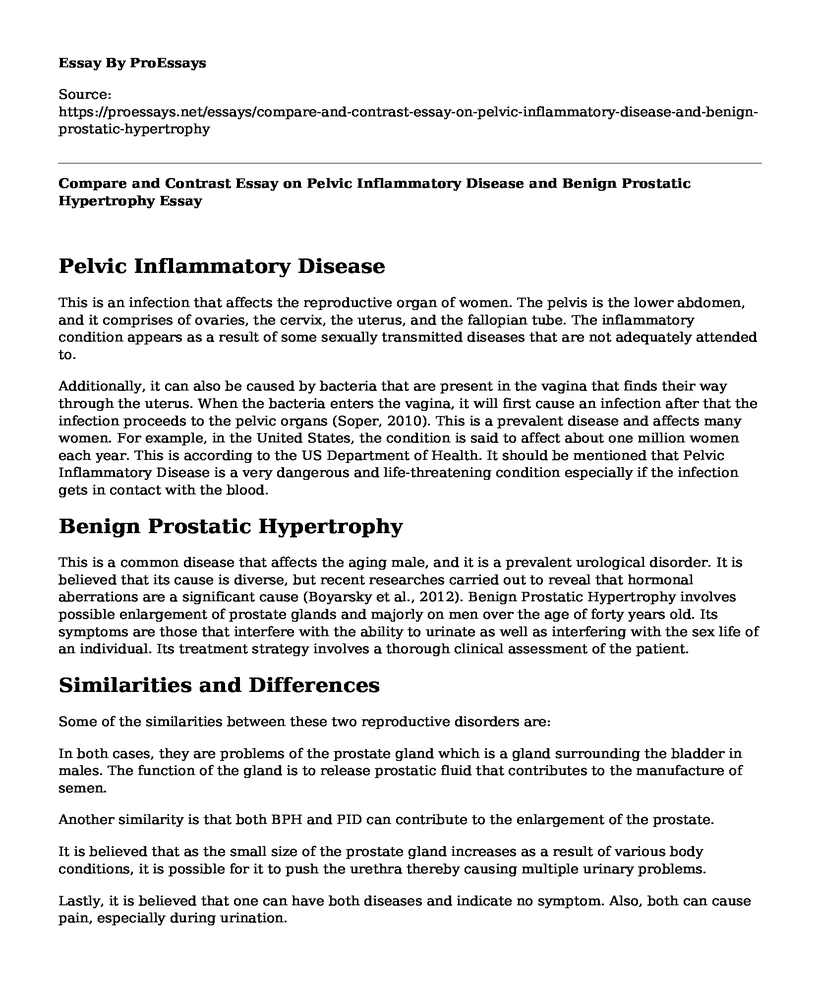Pelvic Inflammatory Disease
This is an infection that affects the reproductive organ of women. The pelvis is the lower abdomen, and it comprises of ovaries, the cervix, the uterus, and the fallopian tube. The inflammatory condition appears as a result of some sexually transmitted diseases that are not adequately attended to.
Additionally, it can also be caused by bacteria that are present in the vagina that finds their way through the uterus. When the bacteria enters the vagina, it will first cause an infection after that the infection proceeds to the pelvic organs (Soper, 2010). This is a prevalent disease and affects many women. For example, in the United States, the condition is said to affect about one million women each year. This is according to the US Department of Health. It should be mentioned that Pelvic Inflammatory Disease is a very dangerous and life-threatening condition especially if the infection gets in contact with the blood.
Benign Prostatic Hypertrophy
This is a common disease that affects the aging male, and it is a prevalent urological disorder. It is believed that its cause is diverse, but recent researches carried out to reveal that hormonal aberrations are a significant cause (Boyarsky et al., 2012). Benign Prostatic Hypertrophy involves possible enlargement of prostate glands and majorly on men over the age of forty years old. Its symptoms are those that interfere with the ability to urinate as well as interfering with the sex life of an individual. Its treatment strategy involves a thorough clinical assessment of the patient.
Similarities and Differences
Some of the similarities between these two reproductive disorders are:
In both cases, they are problems of the prostate gland which is a gland surrounding the bladder in males. The function of the gland is to release prostatic fluid that contributes to the manufacture of semen.
Another similarity is that both BPH and PID can contribute to the enlargement of the prostate.
It is believed that as the small size of the prostate gland increases as a result of various body conditions, it is possible for it to push the urethra thereby causing multiple urinary problems.
Lastly, it is believed that one can have both diseases and indicate no symptom. Also, both can cause pain, especially during urination.
Differences are:
It is worth mentioning that PID is usually caused by bacterial infection and or any other related health issues. However, it has not been established what causes enlarged prostate even though it is similar to hormones (Haggerty & Ness, 2008). Also, as much as BPH can be treated, it cannot be cured. On the other hand, PID is curable in most patients.
Another difference that is worth mentioning is that most men with prostatic also have an infection of the prostate gland even though men with BPH are not affected.
How Age Impacts the Diagnosis of the Two Reproductive Disorders
The diagnosis and subsequent treatment of PID are mostly carried out in any young and sexually active women who have experienced recent onset, lower abdominal pains which are connected with some local tenderness on the bimanual examination which is not part of pregnancy (Haggerty & Ness, 2008). This is because, in young people of the age below 25 years and sexually active women, it is more comfortable and less risky to administer the treatment and diagnosis recommendations.
On the other hand, BPH is a common condition in men over 45 years old. The extent to which the prostate enlarges from man to man as they age (Boyarsky et al., 2012). Because it surrounds the urethra immediately at the bladder exit, it is possible for the prostate to squeeze the urethra as it becomes more significant over time. This disease is the most common disorder of the prostate gland in males of the ages between 45 and 74 years old.
References
Boyarsky, S., Hinman, F. J., Caine, M., Chisholm, G. D., Gammelgaard, P. A., Madsen, P. O., & Zinner, N. R. (2012). Benign prostatic hypertrophy. Springer Science & Business Media.
Haggerty, C. L., & Ness, R. B. (2008). Diagnosis and treatment of pelvic inflammatory disease. Women's Health, 4(4), 383-397.
Soper, D. E. (2010). Pelvic inflammatory disease. Obstetrics & Gynecology, 116(2), 419-428.
Cite this page
Compare and Contrast Essay on Pelvic Inflammatory Disease and Benign Prostatic Hypertrophy. (2022, Jul 29). Retrieved from https://proessays.net/essays/compare-and-contrast-essay-on-pelvic-inflammatory-disease-and-benign-prostatic-hypertrophy
If you are the original author of this essay and no longer wish to have it published on the ProEssays website, please click below to request its removal:
- Essay Sample on Cigarette Packaging
- Essay Sample on The UnitedHealth Group Incorporation
- Benefits of Breastfeeding Essay Example
- Essay Sample on Managing Emergencies and Crisis
- Responding to Emergencies: High-Rise Building Vulnerabilities - Essay Sample
- Essay on Revolutionizing Perioperative Nursing: Integrating Smart Hospital Technologies for Enhanced Patient Care
- Paper on Transformative Roles of Advanced Practice Nurses: Navigating Access, Cost, and Quality in Healthcare







